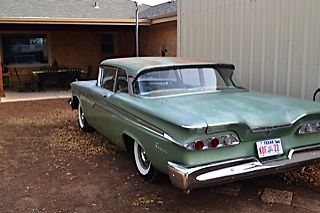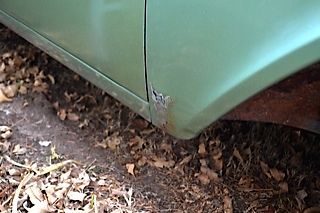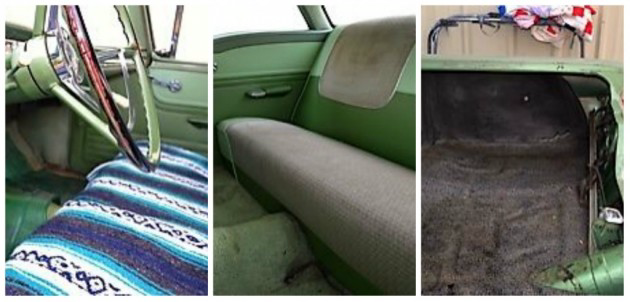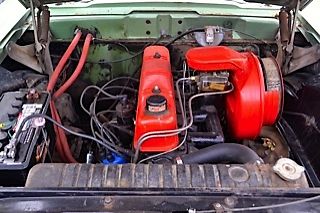1954 Carrera Panamericana-winning Lincoln Capri. Photos courtesy National Automobile Museum (The Harrah Collection), unless otherwise noted.
Intended
to publicize the completion of the Pan-American Highway through Mexico,
the Carrera Panamericana was a grueling multi-day race that stretched
for 2,000-plus miles across all types of terrain. Ferrari would go on to
dominate the sports car class, but American luxury manufacturer Lincoln
ruled the stock car class, winning the event from 1952-1954. Today,
just one of the original “road race Lincolns,” owned by the National
Automobile Museum in Reno, Nevada, is known to exist, and it will be
making a special appearance at the Lincoln Motor Car Heritage Museum, on
the
Gilmore Car Museum campus in Hickory Corners, Michigan, from July 15 through September 15.
Like
the Targa Florio and Mille Miglia, the Carrera Panamericana was held on
public roads without speed restrictions, quickly earning it a lethal
reputation. The first event took place in May of 1950, stretching from
Ciudad Juarez to Ciudad Cuauhtemoc, covering nearly 2,200 miles and
varying in elevation from 328 feet to 10,482 feet. Victory went to an
Oldsmobile 88, though Cadillac and Lincoln automobiles delivered a
respectable showing as well. Three participants and a single spectator
were killed during the course of the event, a number that would rise
sharply as the race grew in significance and popularity.
 Lincoln ad courtesy Lincoln Motor Car Heritage Museum.
Lincoln ad courtesy Lincoln Motor Car Heritage Museum.
The
following year, 1951, the race was run south to north and moved to
November instead of May. Ferrari joined the fray, entering several
factory-backed cars, and ultimately came away with the first and second
place, but larger and heavier American cars (a Chrysler and a Mercury)
took the next two spots. The deaths of numerous competitors prompted an
outcry from the Mexican press, but did little to slow the pace or temper
enthusiasm among participants.
In 1952, the race split into
classes for sports cars and stock cars in order to level the playing
field. Mercedes-Benz joined Ferrari in entering a factory team, and its
tactic of using navigator-read pace to aid the driver was quickly
adopted by the Lincoln team. Mercedes-Benz took the win in the sports
car class, but it was Lincoln who established itself as the team to beat
in the stock car class, capturing the first four positions at race end.
Lincoln
would repeat this remarkable feat in 1953, a year that saw further
division into large and small subcategories within both sports and stock
car classes. The race counted towards the World Sportscar Championship
as well, adding to the importance of a victory (or at least a
respectable showing) for teams contesting the series. It proved to be
the deadliest running of the rally as well, with a total of nine deaths,
eight of these occurring in a single day on one stage.

Though
no one would have predicted it at the race’s start, 1954 would prove to
be the last year for the event. Lincoln once again proved dominant in
the stock car class, earning the first two podium positions at the
conclusion. The winning Lincoln was driven by Ray Crawford and Enrique
Iglesias, completing the 1,908-mile route in 20 hours, 40 minutes and 19
seconds at an average pace of 92.22 MPH. For Crawford (already a World
War II fighter ace), the win would open doors to a racing career that
would include starts in the Indy 500 and in Formula 1.
The 1954
race claimed another seven lives, but it took the death of 84 people at
the 1955 24 Hours of Le Mans to put an end to the Carrera Panamericana.
Public sentiment had (temporarily) turned against racing, but officially
the Carrera Panamericana was canceled because it had achieved its
objective of drawing attention to the Pan-American Highway.
Car
number 149, the 1954 Lincoln Capri driven to victory by Crawford and
Iglesias, found its way into the Harrah Collection, and ultimately the
National Automobile Museum, preserving it from the same fate that likely
befell other racing Lincolns. To prepare the car for the rigors of
competition, the 317.5-cu.in. V-8 was blueprinted, while dual shocks
were used on the front suspension with air shocks fitted to the rear.
Ride height was increased for improved ground clearance, while six-ply
tires were mounted to reduce the chance of punctures. Power brakes were
available on road-going Lincolns, but the racing cars received
unassisted brakes with 12-inch finned drums, instead of the standard
11-inch units.
 The road race Lincoln on display in Reno.
The road race Lincoln on display in Reno.
It
isn’t clear what happened to the other road race Lincolns, though it’s
easy to speculate. Built for competition, chances are good these cars
were raced to the point of failure, or at least until they were no
longer competitive. Some may have been parted out, giving new life to
old Lincolns, while others were simply hauled off for scrap value;
perhaps there’s even a survivor or two parked south of the border, still
waiting to be rescued and restored.
The loan of the 1954 Carrera
Panamericana-winning Lincoln coincides with the second-annual Lincoln
Homecoming event, taking place at the Hickory Corners museum from August
10-14. The event is hosted by the
Road Race Lincoln Register,
one of four Lincoln clubs (including the Lincoln Owners Club, the
Lincoln-Zephyr Owners Club, and the Lincoln & Continental Owners
Club) that supported the construction of the Lincoln Motor Car Heritage
Museum, which opened in August 2014.
For additional information on the Lincoln Homecoming, visit
LincolnCarMuseum.org.
Source: blog.hemmings.com



































